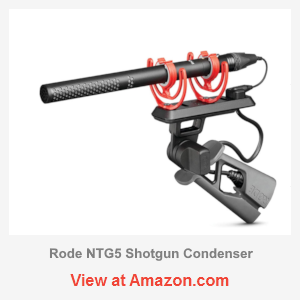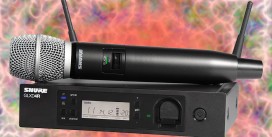RØDE NTG5 is a professional-grade shotgun mic with a twist – it’s incredibly light, compact, and unusually forgiving in the field. Designed as a direct upgrade to the NTG3, it features a radically redesigned interference tube and RF-bias circuitry for superior performance in adverse conditions. NTG5 offers low self-noise, excellent directionality, and a smooth, neutral sound that works beautifully for both location recording and voice-over. It’s not just another Rode – this one plays in the big leagues while still keeping the price surprisingly reasonable.
Build & Design: Light Yet Durable
One of the first things you’ll notice about the Rode NTG5 is how incredibly lightweight it is. Weighing in at just 85 grams (about 3 ounces), it’s among the lightest shotgun mics you’ll find. This may not sound like much, but when you’re running a long shoot, whether handheld or on a boom pole, every gram counts. You won’t even notice it when it’s attached to your rig, and that’s a big win if you’re working with other heavy equipment or running and gunning.
But don’t let the lightweight nature fool you into thinking it’s fragile. The NTG5 is built with durability in mind. Its body is constructed from robust aluminum, and it’s finished in a matte black coating that not only gives it a sleek, professional look but also protects it from wear and tear. While it may not be built to survive being dropped off a building, it’s sturdy enough to handle the rigors of field production and regular use.
Another thoughtful design choice is the custom rycote lyre shock mount. This feature helps isolate the mic from vibrations and handling noise, which is a key factor when you’re recording in environments where even the tiniest rattle or bump can be captured. And unlike other solutions like third-party rubber band suspensions, blimps, or whatever the hell else is out there… this one is free, lightweight, compact, and efficient. Moreover, thanks to the pistol grip, you can actually hold it by hand, yes! So it even makes the boom pole optional (though let’s be real, that’s more of a crutch, and it’s gonna suck ass if you’re doing a long video session).
Bottom line: that pistol grip with rycote lyre + windscreen combination just works – too well, and at no extra cost. It deals with unwanted wind and handling noise beautifully. It’s a clever, cost-efficient solution and really the soul of the NTG5 design – meant to serve as a more lightweight, cheap, and angry alternative to the typical blimp setup. And it’s not just a basic foam windscreen you’re getting, no no. Rode actually throws in a WS10 furry windshield too – and that thing alone is worth like 60 bucks!
Sound Quality: Precision with a Natural Touch
The real beauty of the NTG5 is its sound quality, which is nothing short of impressive. Rode has struck a delicate balance here:
This microphone doesn’t try to artificially shape the sound in any way, which is a refreshing change from mics that tend to add a bunch of unnecessary color (oh yes I’m referring to a more budget-oriented NTG4+ version here). Instead, the NTG5 captures audio with a neutral, transparent tone – exactly what you want from a shotgun mic at a pro level or for any serious production. What you get is clear, detailed audio, with enough presence to pick up subtle nuances in the voice or the sound of your environment. The mic’s wide frequency response (20Hz to 20kHz) means that you’re not losing any important low or high-end frequencies, and even the quietest details are captured with minimal interference.
In terms of directionality, the NTG5 behaves like a typical shotgun mic. Its supercardioid pattern locks onto sound from the front while rejecting the sides and rear significantly. It’s not razor-thin in focus – don’t expect laser-beam isolation. In fact, both the NTG3 and NTG5 lean slightly wider, which makes them more usable in dynamic, real-world situations. You still get clean separation, just without the ‘tunnel vision’. One of the real strengths here is off-axis handling. Unless you’re in a horrible room, reflections and background bleed aren’t going to ruin your take. Off-axis sounds stay clean and natural, not weird or phasey, even though comb filtering is a common problem even for high-end mics. That smooth rejection is the payoff for not chasing hyper-narrow pickup.
But the cream on top here? The NTG5’s impressively low self-noise of just 10 dBA. That’s seriously quiet. For comparison: the NTG4 sits at 16 dBA, the NTG3 at 13 dBA… and even the MKH416 comes in at 13 dBA. So yeah, on paper, it wins. But don’t get too excited about the numbers. These specs are nice to have, sure – but they don’t always reflect real-world performance. Even if the NTG5 ranks among the top five in this area, it doesn’t knock the MKH416 off its throne. Self-noise only becomes a real factor in ultra-quiet environments anyway. In most typical use cases, you won’t notice the difference. Speaking of use cases, we’ve now come to the next point.
Versatility: Wide Range of Use
The Rode NTG5 stands out as an impressively versatile microphone. Whether you’re a content creator, filmmaker, podcaster, or audio engineer, it adapts well to a wide range of workflows and consistently delivers professional-level results.
Film and Video Production
- For film and video work, the NTG5’s focused pickup pattern and excellent off-axis rejection make it a reliable go-to. Whether you’re dealing with unpredictable outdoor environments or working on an indoor set full of ambient distractions, this mic locks onto dialogue with clarity and confidence. Its compact form factor makes it easy to boom or rig, and the extremely lightweight build is a blessing during long shoots – your arms and your crew will thank you.
- It also performs well in field recording. When you need to capture subtle environmental details or isolate specific sound elements, the NTG5 delivers clean, textured recordings without pulling in too much of the surrounding noise. It handles nuanced sound design work with ease, offering clarity without harshness.
- That said, this kind of performance is expected from a mic in this class. If you’re buying a professional shotgun mic, you expect it to handle production audio competently. So while the NTG5 performs admirably in these areas, the real value shows up when you push beyond the traditional use cases.
Streaming and Content Creation
- Where the NTG5 really starts to show its edge is in content creation – especially streaming setups where visual clarity is just as important as sound quality. A lot of streamers default to large dynamic mics like the SM7B, but these often end up dominating the frame, obscuring the face or blocking gestures. On top of that, if you turn your head even slightly, the audio level can drop dramatically. While dynamic broadcast mics have their place and can sound fantastic, they often come with trade-offs in freedom of movement and camera aesthetics.
- The NTG5 offers a refreshing alternative. Mounted just out of frame – either above the camera or off to the side – it captures clean, directional sound without cluttering the shot. This setup gives you much more room to move, emote, or stay visually connected to your audience without being tethered to a mic right in front of your mouth. For visually engaging content where body language and presence matter, this makes a huge difference.
- And just to be clear, it’s not limited to out-of-frame use. Like its more expensive cousin, the MKH416, the NTG5 also works surprisingly well for close-up voiceover work when used in the traditional way. So if you’re doing occasional narration or need to lay down a clean voice track, it won’t disappoint! And more icing on top? Rode actually includes a solid shock mount and wind protection in the package – and this is where the value comes from. Just throw it on a mic stand, and you’re set.
Overhyped or Just Right?
Is the Rode NTG5 overhyped? That really depends on what you’re expecting – and what you’re comparing it to. Let’s break it down into a few real-world factors that can help you decide:
1. Price. If the MKH416 is out of reach and the NTG5 lands in your budget sweet spot, it’s a solid buy. But if the price difference is small, it might be smarter to just go with the industry standard. That way, you won’t end up wondering later if you should’ve just gotten the 416 in the first place.
2. Footprint. The NTG5 is lighter and less bulky than the MKH416 + blimp combo, which matters if you’re working long shoots or want a setup that’s easier to handle. It fits nicely into minimalist rigs or solo setups.
3. Included gear. Rode packs in a high-quality Rycote shock mount and wind protection out of the box. If you’re planning to use those straight up without investing in extra gear, you’re already saving more than you might think.
Bottom line: If you’re budget-conscious and care about staying lightweight, the NTG5 is a smart move. But if you’re already close to MKH416 territory, might as well go all in and be done with it. Don’t let the hype make your decision – just weigh what matters in your use case.
Now, to be fair, the NTG5 doesn’t lean on flashy gimmicks or try to win over casual users with exaggerated specs. That’s a good thing. It’s a pro-oriented tool that keeps things clean and effective. No magic tricks, just solid sound you can rely on. And if you’re doing pro work, you already know EQ and post-processing are part of the game. So yeah – less flash, more function. That’s the real appeal.
Final Verdict
If you’re looking for a professional shotgun mic that doesn’t weigh you down – physically or financially – the RØDE NTG5 hits a rare sweet spot. It brings clean, neutral sound, decent directionality, and an impressively low noise floor, all wrapped in a featherweight body with some genuinely useful accessories thrown in. No, it’s not the legendary MKH416, and it doesn’t try to be. But that’s exactly the point. The NTG5 is for people who want something lighter, more affordable, and still totally capable of delivering broadcast-quality results. If that’s what you’re after, there’s a good chance you’ll find the NTG5 isn’t just a smart buy – it’s the right one. If you’re ready to step up your audio game without breaking the bank, the NTG5 is a no-nonsense tool that punches way above its price tag.
- Reviewed at $499
Pros:
- Lightweight / small footprint
- Proprietary rycote lyre shock mount
- Professional sound quality + neutral response
- Free Rode WS10 Furry Windshield
- Arguably offers more bang for the buck
- Versatility – filmmaking, voiceovers, streaming
- Ultra quiet, extremely low self-noise
- Excellent resistance to moisture
Cons:
- Like the NTG3, its directionality isn’t razor-sharp. You’ll pick up more off-axis sound than with some higher-end shotguns.
- Depending on current pricing, the MKH416 might be the better buy. If the difference isn’t big, it’s worth considering the upgrade.
- Make sure your seller is Rode-authorized. Otherwise, your warranty’s void—and at this price, that’s not a risk you want to take.
WARNING! MAKE SURE YOUR AMAZON SELLER IS AUTHORIZED: https://rode.com/en/support/where-to-buy










